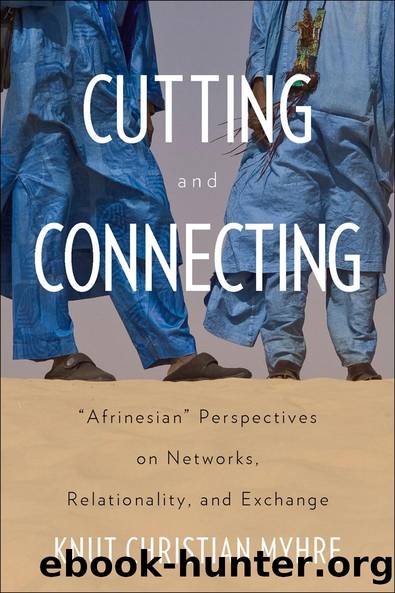Cutting and Connecting by Knut Christian Myhre

Author:Knut Christian Myhre [Myhre, Knut Christian]
Language: eng
Format: epub
ISBN: 9781785332630
Barnesnoble:
Publisher: Berghahn Books, Incorporated
Published: 2016-03-01T00:00:00+00:00
Work, Gender, and Sociality: Multiplying Obligations to Curtail Claims
In relational contexts, the changing construction of gender mutuality can profoundly affect collective solidarities. Strathern (1988: 74â75) suggests that the tendency in the Western cultural discourse to represent the public-domestic divide through male-female polarization has its underlying assumptions about power and control: women are associated with the domestic realm and are seen as less likely than men to participate in organized collectivities. However, in several recent contexts of changing Melanesian subsistence economies (in Hagen, Vanuatu, and Daulo), women appear to be intensely involved with broader social orientations and novel collective endeavors (ibid.: 76â86). But this does not imply that the new gendered activities have reordered the social domains or increased womenâs participation in local politics, according to Strathern. Instead of assuming womenâs empowerment or gender-based polarization as a concomitant of âmodernâ changes, it is important to investigate the nature of emerging socialities and their relation to shifts in collective activities.
The Kuria house property complex, with its intriguingly complex gender dynamics, has played a significant role in defining the emerging collectivities. Relationships in these complexes were shaped by the materiality of culturally significant flows of exchange, most notably cattle and labor transfers. The role of bride-wealth cattle as a means of transferring a womanâs fertility and labor power was expressed in the cultural principle that âcattle, not seeds, countâ (see also Bernhardsdotter 2001). This provided women with an effective array of materially grounded strategies for cutting relationships wrought with conflict or excessive demands.
Despite widespread polygyny and levirate (whereby a man marries his brotherâs widow), both men and women in the Kuria household had access to a range of options and resources. The âextended family householdâ (umugi) that is formed after a manâs marriage consists of the âmatrifocal housesâ (inyuumba) of his wives and daughters-in-law, through which descent and property inheritance are traced. Bride-wealth cattle attached the labor power of daughters-in-law to the houses of their mothers-in-law, enabling the latter to rise in wealth and prestige. This also made it possible for an older woman to âbranch offâ from her husbandâs umugi in case of conflicts and effectively set up her own house and lineage with her sons and daughters-in-law (see Bernhardsdotter 2001: 70).
More recently, other options to cut the limiting relationship flows have emerged along the lines of the same cultural principle. One such arrangement is Kuria âwoman-to-woman marriageâ (omokamoona), which provides the means for a woman who does not have a son to continue her house by attaching daughters-in-law through bride-wealth cattle. The institution of omokamoona is quite recent, dating from the beginning of the twentieth century (Rwezaura 1985). Its relevance has grown with the increasing spread of the money economy, with women using cash to purchase cattle and set up their own âextended familiesâ. It can also serve as a means for divorced or separated women to set up a business enterprise. Although it affords women more economic initiative, contemporary woman-to-woman marriage remains dependent on socially recognized ties and connections. As
Download
This site does not store any files on its server. We only index and link to content provided by other sites. Please contact the content providers to delete copyright contents if any and email us, we'll remove relevant links or contents immediately.
Cecilia; Or, Memoirs of an Heiress — Volume 1 by Fanny Burney(32028)
Cecilia; Or, Memoirs of an Heiress — Volume 3 by Fanny Burney(31439)
Cecilia; Or, Memoirs of an Heiress — Volume 2 by Fanny Burney(31388)
The Great Music City by Andrea Baker(30761)
We're Going to Need More Wine by Gabrielle Union(18609)
All the Missing Girls by Megan Miranda(14628)
Pimp by Iceberg Slim(13756)
Bombshells: Glamour Girls of a Lifetime by Sullivan Steve(13667)
Fifty Shades Freed by E L James(12890)
Talking to Strangers by Malcolm Gladwell(12828)
Norse Mythology by Gaiman Neil(12794)
For the Love of Europe by Rick Steves(11341)
Crazy Rich Asians by Kevin Kwan(8865)
Mindhunter: Inside the FBI's Elite Serial Crime Unit by John E. Douglas & Mark Olshaker(8669)
The Lost Art of Listening by Michael P. Nichols(7139)
Enlightenment Now: The Case for Reason, Science, Humanism, and Progress by Steven Pinker(6856)
The Four Agreements by Don Miguel Ruiz(6291)
Bad Blood by John Carreyrou(6259)
Weapons of Math Destruction by Cathy O'Neil(5805)
